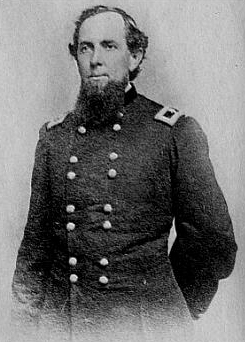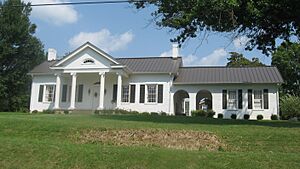Edward H. Hobson facts for kids
Quick facts for kids
Edward Henry Hobson
|
|
|---|---|
 |
|
| Born | July 11, 1825 Greensburg, Kentucky |
| Died | September 14, 1901 (aged 76) Cleveland, Ohio |
| Place of burial |
Family Cemetery, Greensburg, Kentucky
|
| Allegiance | United States of America Union |
| Service/ |
United States Army Union Army |
| Years of service | 1846–1847; 1861–1865 |
| Rank | |
| Commands held | 13th Kentucky Infantry |
| Battles/wars | Mexican War American Civil War |
| Other work | IRS Collector |
Edward Henry Hobson (born July 11, 1825 – died September 14, 1901) was an important American figure. He was a businessman, a banker, and even worked for the government collecting taxes. He also served as an officer in the United States Army during two major conflicts: the Mexican–American War and the American Civil War. He is especially remembered for his determined chase of Confederate General John Hunt Morgan during a famous event called Morgan's Raid.
Contents
Edward Hobson: Early Life and First War
Edward Henry Hobson was born in Greensburg, Kentucky. His father, Captain William Hobson, worked with steamboats and was a merchant. Edward went to local schools in Greensburg and Danville, Kentucky.
When he was eighteen, Edward joined his father's business. In 1846, he signed up for the 2nd Kentucky Volunteer Infantry. He served in the Mexican–American War. He quickly became a first lieutenant. He fought bravely in the Battle of Buena Vista in February 1847. A few months later, he returned home. He went back to working in his family's business. In 1853, he became a director at the Greensburg branch of the Bank of Kentucky. He was the bank's president from 1857 until 1861. Edward married Katie Adair, who was the niece of Kentucky Governor John Adair.
Civil War: A General's Journey
When the American Civil War began, Edward Hobson helped create a new army unit. He became the Colonel of the 13th Regiment Kentucky Volunteer Infantry. This unit was based near Greensburg at "Camp Hobson." In February 1862, he moved his troops south with General Don Carlos Buell's army.
Rising Through the Ranks
Colonel Hobson led his regiment successfully at the Battle of Shiloh. Because of his good work, President Abraham Lincoln suggested he be promoted. He was to become a brigadier general. Before getting this new rank, he took part in the Siege of Corinth in Mississippi. Later, Hobson commanded a group of soldiers at the Battle of Perryville.
Chasing Morgan's Raiders
Finally, Edward Hobson received his promotion to brigadier general. He was put in charge of Union troops in his home state of Kentucky. His main job was to watch the movements of Confederate General John Hunt Morgan. In July 1863, during Morgan's Raid, General Hobson and three brigades of soldiers chased Morgan. They pursued him through Kentucky, Indiana, and Ohio.
Hobson's forces dealt a big blow to Morgan's raiders. This happened at the Battle of Buffington Island. There, Hobson captured most of Morgan's men. After this, he was asked to lead General Ambrose Burnside's cavalry. However, due to health issues, he could not take on this role.
Later in the war, Hobson again led troops. He helped stop Confederate attacks near Lexington, Kentucky. In June 1864, something ironic happened. General Morgan captured Hobson and about 750 of his men near Cynthiana, Kentucky. But Hobson was able to negotiate his release. He then commanded a group of Kentucky mounted infantry and cavalry. They fought at the First Battle of Saltville in October. He left the army in August 1865.
After the war, he joined a group for military officers called the Military Order of the Loyal Legion of the United States.
Life After the War
After the war, Hobson returned home to his business. He became involved in politics, joining the Radical Republicans. He ran for clerk of the state Court of Appeals but did not win. This election was very difficult. His support for the Thirteenth and Fourteenth Amendments cost him the election. These amendments were about ending slavery and giving rights to former slaves.
In 1872, Hobson tried to become a member of the United States House of Representatives. He ran for Kentucky's 4th District, but he was defeated again. In 1880, he was a delegate at the Republican National Convention. He was a vice-president at the convention. He strongly supported Ulysses S. Grant becoming president. President Grant later appointed Hobson as the district collector for the internal revenue. This meant he collected taxes for the government.
In 1887, he became the president of the Southern Division of the Chesapeake and Ohio Railway. He was very active in the Grand Army of the Republic, a group for Civil War veterans. Edward Henry Hobson died in Cleveland, Ohio, while attending one of their meetings. He was buried in his family's graveyard in Greensburg, Kentucky.
His family home in Greensburg, built in 1823, is a special historic building. It is listed on the National Register of Historic Places. As of 2010, the house had been fully restored.


